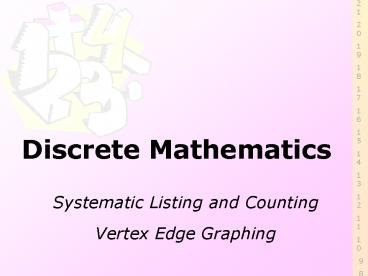Systematic Listing and Counting - PowerPoint PPT Presentation
1 / 36
Title:
Systematic Listing and Counting
Description:
Discrete mathematics is the branch of mathematics that ... Dora the Explorer. Tarp Map. The Princess and the Tiger. 21. 20. 19. 18. 17. 16. 15. 14. 13. 12 ... – PowerPoint PPT presentation
Number of Views:1759
Avg rating:3.0/5.0
Title: Systematic Listing and Counting
1
Discrete Mathematics
- Systematic Listing and Counting
- Vertex Edge Graphing
2
What is Discrete Math?
Discrete mathematics is the branch of mathematics
that deals with arrangements of distinct objects.
It includes a wide variety of topics and
techniques that arise in everyday life, such as
how to find the best route from one city to
another where the objects are cities arranged on
a map. It also includes how to count the number
of different combinations for toppings for
pizzas, how to best schedule a lists of tasks to
be done, and how computers store and retrieve
arrangements of information on a screen.
3
What is Discrete Math?
Discrete mathematics is the mathematics used by
decision makers in our society, from workers in
government to those in health care,
transportation, and telecommunications. Its
various applications help students see the
relevance of mathematics in the real world.
4
Themes of Discrete Mathematics
- Systematic Listing and Counting
- Using Discrete Mathematical Models
- Applying Iterative Patterns and Processes
- Organizing and Processing Information
- Finding the Best Solution Using Algorithms
5
Systematic Listing and Counting
- Elementary students should be able to make a list
of all the possible outcomes of a simple
situation such as the number of outfits that can
be worn using two coats and three hats.
6
Using Discrete Mathematical Models
- Elementary students should recognize that a
street map can be represented by a graph and that
routes can be represented by paths in graphs.
7
Applying Iterative Patterns and Processes
- Elementary students should be able to recognize
and investigate sequences on pinecones and
patterns on floor tiling.
8
Organizing and Processing Information
- Elementary students should be able to investigate
ways to represent and classify data according to
attributes like color or shape, using
relationships like family trees, and into
structures like tables
9
Finding the Best Solution Using Algorithms
- Elementary students should be able to discuss
different ways of dividing up a pile of snacks,
and should determine the shortest path from one
site to another on a map laid out on a classroom
floor
10
Discrete Math Technology Standards
- Standard 3 Students use technology tools to
enhance learning, to increase productivity and
creativity and to construct technology-enhanced
models, prepare publications and to produce other
creative works. - Standard 6 Students use technology to make and
support decisions in the process of solving
real-world problems.
11
Systematic Listing andCounting
- What are some ideas you have
- about items that can be combined?
12
Cookie Combinations
Today we will be making different cookies to
eat. We have sugar cookies. On our cookies we
will spread one kind of frosting, vanilla or
chocolate. We will also put one kind of
sprinkle, chocolate or red/white/blue. How
many different cookie combinations can we make?
13
Other Combination Ideas
- Ice Cream Sundae Scoops, Mix-In,
Double/Triple Dip - Fish Bowl
- Flower Bouquet
- Outfits
- Line Order
14
Systematic Listing andCounting
- Do you have additional ideas about items that can
be combined? - Each group will take one of the ideas from the
list and write a problem that would be
appropriate for kinder or 1st grade. - PO 1. Make arrangements that represent the
number of - combinations that can be formed by pairing items
taken from - 2 sets, using manipulatives (e.g., How many
outfits can one - make with 2 different color shirts and 2
different pairs of - pants?).
15
Math for Us
- Probability Grand Prix
16
Vertex Edge Graphing
- What is it???
- Reasoning and thought processes that you use
when - constructing a seating chart
- make a schedule for a field trip or conferences
- determine the order and route for your errands
17
Vertex Edge Graphing
- What are the fewest number of colors needed so
that no touching edges share the same color on
each design? Do you notice any patterns? - Construct designs of your own that would need to
be colored with 2, 3, 4, and 5 colors.
18
(No Transcript)
19
(No Transcript)
20
(No Transcript)
21
(No Transcript)
22
(No Transcript)
23
Vertex Edge Graphing with Children
- What question/prompt might you pose to children
to help them complete a vertex edge design? - How could the performance objective be written in
kid friendly language? - PO 1. Color pictures with the least number of
colors so that no common edges share the same
color (increased complexity throughout grade
levels).
24
Vertex Edge Graphing with Children
- Elmer the Patchwork Elephant
- Flags
- Tesselations
- Quilts
25
Vertex Edge Graphs
- Vertex Coloring
26
Different or Shortest Routes
- Dora the Explorer
- Tarp Map
- The Princess and the Tiger
27
AIMS Sample S2C3 (Gr. 3)
28
AIMS Sample S2C3 (Gr. 3)
29
AIMS Sample S2C3 (Gr. 4)
30
AIMS Sample S2C3 (Gr. 5)
31
AIMS Sample S2C3 (Gr. 5)
32
AIMS Sample S2C4 (Gr. 3)
33
AIMS Sample S2C4 (Gr. 4)
34
AIMS Sample S2C4 (Gr. 4)
35
AIMS Sample S2C4 (Gr. 5)
36
AIMS Sample S2C4 (Gr. 5)































